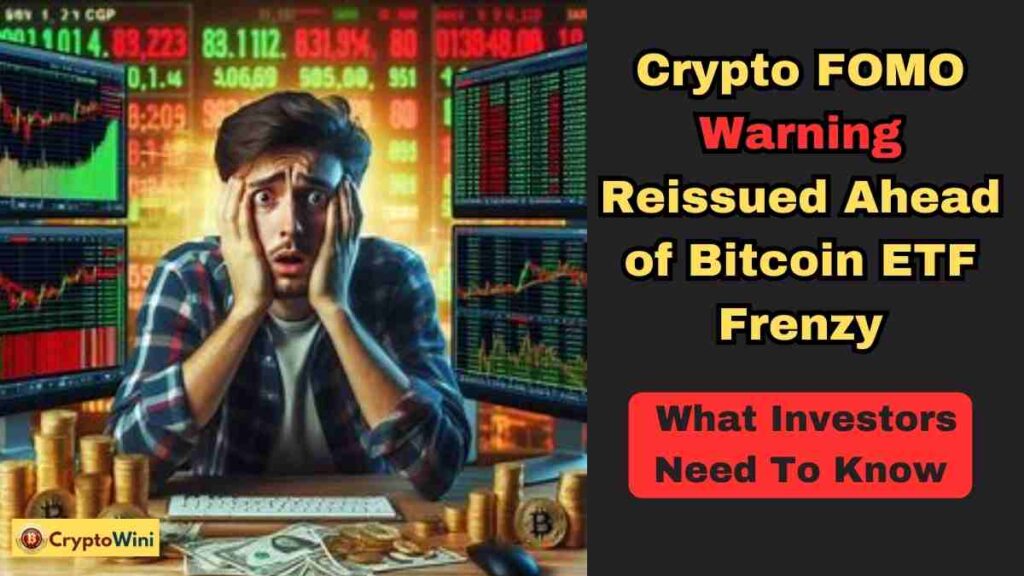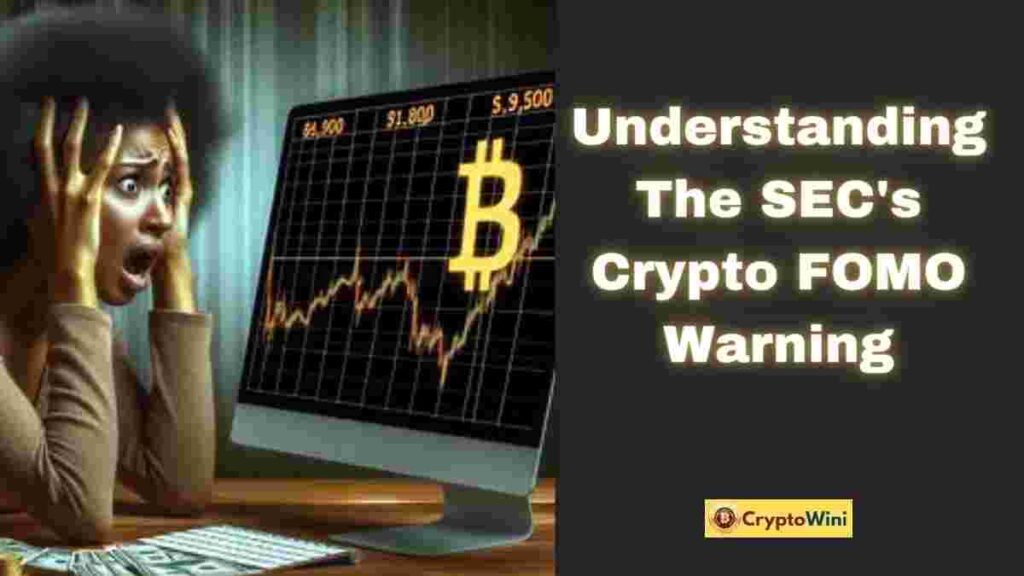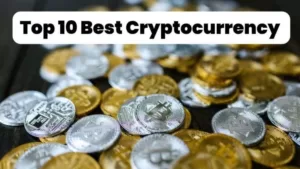{ sec warning, bitcoin etf, crypto fomo, bitcoin etf approval, bitcoin etf sec, sec bitcoin etf decision, spot bitcoin etf, bitcoin etf structure, bitcoin etf launch, evaluating bitcoin etfs, futures bitcoin etf, bitcoin etf trusts, bitcoin etf retail investors, crypto fomo factors, bitcoin etf impact, bitcoin etf adoption, bitcoin etf market impact }

SEC Sounds Alarm on Crypto FOMO Ahead of Imminent Bitcoin ETF Launches
The U.S. Securities and Exchange Commission (SEC) recently reissued a warning to retail investors about the risks of buying into crypto hype and making investment decisions based on FOMO (fear of missing out). This cautionary note comes just as the crypto community awaits the SEC’s decision on several spot Bitcoin ETF applications by the January 8th deadline.
The SEC warning and looming Bitcoin ETF decisions signal an inflexion point in the maturation of the crypto asset class. While increased regulatory clarity and mainstream access via ETFs can accelerate crypto adoption, investors must temper emotions and make informed decisions. Examining the crypto FOMO phenomenon and nuances around different ETF structures can equip investors to navigate this new phase in crypto’s evolution.

Understanding the SEC’s Crypto FOMO Warning
The SEC’s Office of Investor Education urged retail investors to avoid FOMO and make level-headed decisions, especially amid hype around digital assets like meme stocks, cryptocurrencies, and NFTs.
Specifically, the warning cautions against:
- Relying on recommendations from celebrities, influencers, and athletes promoting crypto. Do your own research.
- Getting drawn in by social media hype and meme culture surrounding certain crypto assets. Don’t invest more than you can afford to lose.
- Assuming past high returns mean future success. Crypto markets are extremely volatile.
- Underestimating crypto’s risks and complexities. Many cryptos lack investor protections.
The report also highlighted crypto’s extreme price swings, noting assets can lose 20-50% overnight when manias subside.
This isn’t the SEC’s first anti-FOMO warning. They initially issued it in January 2021 during the bull market mania, and again in March 2022 as markets cooled off. The latest re-issue comes right before major Bitcoin ETF decisions.

Why Bitcoin ETF Approval Could Fuel FOMO
The SEC is expected to approve several spot Bitcoin ETFs by January 8th based on filings meeting their requirements. These include funds from Grayscale, SkyBridge, and Fidelity.
Bitcoin ETFs allow mainstream investors to gain exposure to crypto markets more easily via traditional brokerage accounts and retirement funds, without handling cryptocurrencies directly.
Many analysts anticipate Bitcoin ETF approval will drive institutional investment and fuel mass retail FOMO. Key implications include:
Mainstreaming Crypto
- ETF accessibility erodes barriers to crypto investing for retail investors.
- The “crypto curious” can participate in Bitcoin upside without complex wallets or exchanges.
- Further legitimacy for crypto as an asset class on par with stocks and bonds.
Incentivizing Institutions
- Institutions gain regulated crypto exposure amid client demand.
- Unlocks trillions in retirement accounts for crypto allocation.
- Custody and auditing from fund providers alleviate security concerns.
Impact on Bitcoin Price
- Potentially significant fund inflows add buying pressure.
- Increased demand could push Bitcoin prices higher short term.
- May moderate volatility over the longer term as institutional exposure grows.
However, as the SEC notes, investors should base decisions on due diligence, not manias or price chasing.

Crypto FOMO: A Real Phenomenon Among Retail Investors
The SEC’s repeated warnings indicate that FOMO is a real issue plaguing crypto retail investors. Some factors contributing to outsized FOMO include:
Crypto Market Volatility
- Extreme, rapid price swings spur investors to rush into assets like Bitcoin after large upside moves.
- Crash risk also fuels FOMO – fear of exiting before a rebound.
Speculative Manias
- Influencers and hype on forums like Reddit fan speculative frenzies around assets like Dogecoin.
- Investors fear missing meme stock-like gains.
Limited Supply Cryptos
- Scarcity fuels frenzy to gain exposure before supply caps like Bitcoin’s 21 million limit.
- Further diminished availability is expected in future.
Early Adopter Riches
- Stories of massive wealth created by early Bitcoin and Ethereum buyers drive retail FOMO.
- Dream of replicating early investor success.
Mainstream Hype Cycles
- Media coverage and crypto exchange ads during bull markets attract the “crypto curious.”
- Retail pours in due to hype despite bubble risk.
Understanding these root causes can help investors manage emotions and avoid buying at unsustainable peak prices.

Evaluating the Impact of Different ETF Structures
As Bitcoin ETF approval approaches, it’s essential to evaluate the differences between various fund structures under consideration:
Spot Bitcoin ETF
- Tracks Bitcoin price directly and holds BTC.
- Provides direct exposure with high correlation to Bitcoin.
- Allows efficient price discovery and arbitrage.
Bitcoin Futures ETF
- Tracks Bitcoin futures contracts instead of spot holdings.
- Increased cost through contango slippage on futures rollovers.
- Often trails spot BTC performance significantly.
Closed-End Fund
- Operates like an ETF but with a fixed number of shares.
- Doesn’t always precisely track net asset value (NAV) of holdings.
- Potential for shares to trade above or below NAV.
Trusts
- Owns underlying crypto assets on behalf of shareholders.
- Converts holdings like Bitcoin into shares tradable on exchanges.
- Subject to premiums/discounts to BTC values like closed-end fund.
Of these, a spot Bitcoin ETF structure would provide the most direct and efficient Bitcoin exposure for retail investors. But nuances around the mode of exposure matter greatly.
FAQs
Q: What is the SEC crypto warning about?
A: The SEC is warning retail investors about making investment decisions based on FOMO and hype, especially in highly volatile crypto markets.
Q: Why did the SEC reissue this crypto FOMO warning now?
A: The timing coincides with pending decisions on several Bitcoin ETF applications, which could drive increased retail interest.
Q: How could Bitcoin ETF approval impact crypto markets?
A: Bitcoin ETFs could spur significant institutional investment inflows, introduce mainstream retail investors, and potentially push crypto prices higher short term due to increased demand.
Q: What causes some investors to experience crypto FOMO?
A: Key factors include crypto’s extreme volatility, speculative manias, scarcity of limited supply coins, stories of vast wealth from early adopters, and mainstream hype cycles.
Q: What are the differences between a spot Bitcoin ETF and a futures-based ETF?
A: A spot Bitcoin ETF invests directly in and holds BTC, while a futures ETF tracks Bitcoin futures contracts. The latter is more complex and often underperforms spot price tracking.
Q: What should cautious investors do in the new crypto ETF era?
A: Carefully evaluate risk tolerance, analyze ETF investment structures, avoid trying to time peaks, and use dollar cost averaging and portfolio allocation strategies.
Q: Does crypto ETF access mean investors should disregard the SEC’s warning?
A: No. While easier access promotes adoption, investors should still research thoroughly and avoid irrational hype-based FOMO investing even with ETFs.
Q: What precautions can investors take against crypto FOMO?
A: Perform due diligence beyond hype, evaluate project fundamentals, establish prudent position sizing, use dollar cost averaging, and invest based on logic over emotions.
Key Takeaways – Caution Against FOMO, But Crypto ETFs Promise Easier Access
The SEC’s latest warning reminds us that FOMO can be an unwise investment motivator, especially in crypto’s volatile environment. However, conservative exposure through long-term ETF investments could offer meaningful portfolio diversification for suitable investors.
As Bitcoin ETFs unlock broader retail participation, investors would do well to:
- Evaluate risk tolerance and investment time horizons.
- Analyze ETF structures to understand exposure implications.
- Avoid trying to time markets or chase sudden price spikes.
- Use dollar cost averaging and portfolio allocation strategies.
The emergence of crypto ETFs means easier access but also increased responsibility. Instead of fear of missing out, investors should focus on taking a prudent, measured approach to this asset class.
Also Read :
SEC Confirms Hack of Twitter Account and Fake Bitcoin ETF Approval
Is Riot Blockchain The Next $500K Stock? RIOT Stock Forecast For 2024 And Beyond
India Crypto Regulation-Blocks Binance And 8 Other Crypto Exchanges: Know Why?
How Would A BlackRock Bitcoin Spot ETF Disrupt The Crypto Market In 2024?
Bitcoin Price Prediction 2024: Factors Influencing a $100K Surge






























